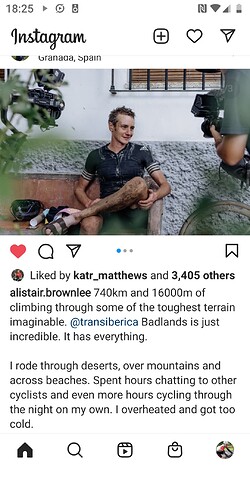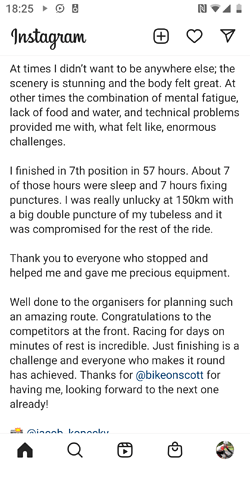He has a bike/kit video on insta i haven’t watched yet… was he running tubeless ?
Probably chose lower RR over puncture resistance (and comfort). That will bite over these distances on little sleep.
Can’t remember but he was running Zipp 303s which seems quite a racy wheel for something like this!
He was using Schwalbe G-One R, which according to Schwalbe should have good protection. He said he had loads of sealant and plenty of spare tubes.
Ah I guess if your tubeless hasn’t sealed and you can’t get it to work with a worm or tyre patch… once you’ve put a tube in you’ll end up fixing that all the time anyway 
I know my evidence is just one person’s but I’ve never had any luck with any of the Schwalbe ‘protection’ tyres. I’ve tried 3 types and ended up with more punctures than usual with all of them.
That was a few years ago but I was genuinely left scratching my head about why folks were singing their praises?
I used to commute on the Schwalbe marathon but that was a slick MTB tyre and they were great. I have always used Conti gatorskins on road bikes in winter or commmuting.
That’s a good point. May be worth me whipping my GP5000s off at the end of September and chucking on some slower, tougher tyres for the weekly trip to work and back. Are the latex inners any less ‘tough’? I seem to recall @JibberJim saying they were fine, i think, but that they lose pressure quicker, so need regular pumping. Not sure if i remembered that correctly or not.
Yes, the deflection of latex means there’s more puncture protection.
However with the increased risk of punctures in the winter (wetter roads and more shit on the road) and the endless pumping, I wouldn’t keep latex innners in for commuting.
Yes, latex tubes will need pumping each ride. Will lose like 2 psi/hour.
That seems high? Most of what I’ve read elsewhere has suggested 20psi/24hrs, or roughly 1psi/hr. That’s not such a big deal over the course of an Ironman, but losing upwards of 15psi (when you factor in the time between pumping up, milling around, the swim, then a 5-6hr ride) is quite a bit more significant.
It was an estimate, I guess it will depend on the pressure.
OK, thanks. Was just making me reconsider the benefit of latex in a full distance if that was the potential loss by the end. Simplest thing would be for me to do a test!
I’ve run latex for IMs and 12 hr TTs never noticed any issues of lost pressure.
One thing is make sure spare tubes are butyl, latex is a bit of a faff to get in correctly without the escaping pink bubble of death. I’ve lost a few not installing properly….BANG!!!
It’s doable, talc helps but I wouldn’t want to be doing it roadside in the rain……
The other reason not to have latex spares is while they lose a bit of pressure with air they are like a sive when filled with nitrogen from a canister due to the much smaller molecule size.
Thinking about is 2 psi/hour is not likely, they have always been fine for me on day races. For IM there likely will be a net increase in pressure due to temperature from early morning inflation to the start of the bike leg anyhow.
who has cannisters of nitrogen though? CO2 all the way, and CO2 is bigger than air, but it still leaks out quicker than air 'cos it disolves in latex (disolves in butyl too which is why the normal butyl tubes are down the next day after a quick repair too)
(I’m not completely sure disolves is the right chemistry like effect between a gas and a solid here, but it’s getting out more analgous to that than because of any tiny holes in the latex)
I said nitrogen but meant CO2. Your chemistry is clearly better than mine, I just knew they don’t stay up with the canisters.
More gravel action…


